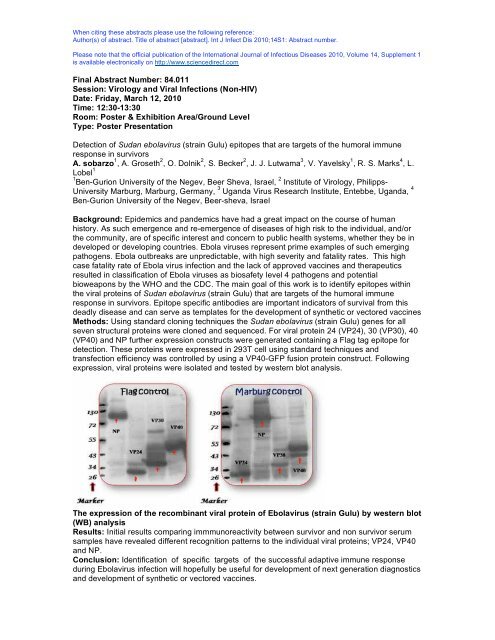14th ICID - Poster Abstracts - International Society for Infectious ...
14th ICID - Poster Abstracts - International Society for Infectious ...
14th ICID - Poster Abstracts - International Society for Infectious ...
Create successful ePaper yourself
Turn your PDF publications into a flip-book with our unique Google optimized e-Paper software.
When citing these abstracts please use the following reference:<br />
Author(s) of abstract. Title of abstract [abstract]. Int J Infect Dis 2010;14S1: Abstract number.<br />
Please note that the official publication of the <strong>International</strong> Journal of <strong>Infectious</strong> Diseases 2010, Volume 14, Supplement 1<br />
is available electronically on http://www.sciencedirect.com<br />
Final Abstract Number: 84.011<br />
Session: Virology and Viral Infections (Non-HIV)<br />
Date: Friday, March 12, 2010<br />
Time: 12:30-13:30<br />
Room: <strong>Poster</strong> & Exhibition Area/Ground Level<br />
Type: <strong>Poster</strong> Presentation<br />
Detection of Sudan ebolavirus (strain Gulu) epitopes that are targets of the humoral immune<br />
response in survivors<br />
A. sobarzo 1 , A. Groseth 2 , O. Dolnik 2 , S. Becker 2 , J. J. Lutwama 3 , V. Yavelsky 1 , R. S. Marks 4 , L.<br />
Lobel 1<br />
1 Ben-Gurion University of the Negev, Beer Sheva, Israel, 2 Institute of Virology, Philipps-<br />
University Marburg, Marburg, Germany, 3 Uganda Virus Research Institute, Entebbe, Uganda, 4<br />
Ben-Gurion University of the Negev, Beer-sheva, Israel<br />
Background: Epidemics and pandemics have had a great impact on the course of human<br />
history. As such emergence and re-emergence of diseases of high risk to the individual, and/or<br />
the community, are of specific interest and concern to public health systems, whether they be in<br />
developed or developing countries. Ebola viruses represent prime examples of such emerging<br />
pathogens. Ebola outbreaks are unpredictable, with high severity and fatality rates. This high<br />
case fatality rate of Ebola virus infection and the lack of approved vaccines and therapeutics<br />
resulted in classification of Ebola viruses as biosafety level 4 pathogens and potential<br />
bioweapons by the WHO and the CDC. The main goal of this work is to identify epitopes within<br />
the viral proteins of Sudan ebolavirus (strain Gulu) that are targets of the humoral immune<br />
response in survivors. Epitope specific antibodies are important indicators of survival from this<br />
deadly disease and can serve as templates <strong>for</strong> the development of synthetic or vectored vaccines<br />
Methods: Using standard cloning techniques the Sudan ebolavirus (strain Gulu) genes <strong>for</strong> all<br />
seven structural proteins were cloned and sequenced. For viral protein 24 (VP24), 30 (VP30), 40<br />
(VP40) and NP further expression constructs were generated containing a Flag tag epitope <strong>for</strong><br />
detection. These proteins were expressed in 293T cell using standard techniques and<br />
transfection efficiency was controlled by using a VP40-GFP fusion protein construct. Following<br />
expression, viral proteins were isolated and tested by western blot analysis.<br />
The expression of the recombinant viral protein of Ebolavirus (strain Gulu) by western blot<br />
(WB) analysis<br />
Results: Initial results comparing immmunoreactivity between survivor and non survivor serum<br />
samples have revealed different recognition patterns to the individual viral proteins; VP24, VP40<br />
and NP.<br />
Conclusion: Identification of specific targets of the successful adaptive immune response<br />
during Ebolavirus infection will hopefully be useful <strong>for</strong> development of next generation diagnostics<br />
and development of synthetic or vectored vaccines.
















